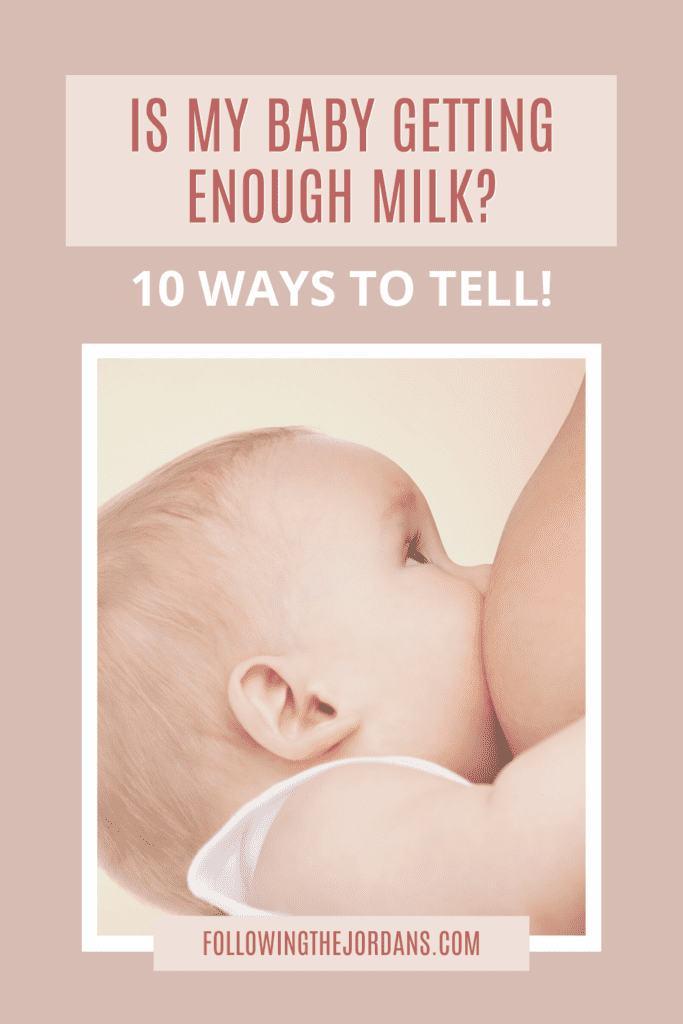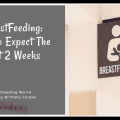Is My Baby Getting Enough Milk? 10 Ways to Tell
Determining if your baby is getting enough milk while breastfeeding isn’t as easy as tracking the ounces. It’s impossible to measure, so you have to watch for the obvious signs that your baby is consuming enough breast milk.
In the early days, your breasts make colostrum, a nutrient-dense, thick milk that is vital for your baby’s immune system. Babies need this, but they won’t consume a lot. An average newborn’s stomach is the size of a marble for the first days and starts to grow larger over the next month.
If your baby consumes colostrum regularly, they won’t starve, but losing weight is normal. Babies often lose up to 7-10% of their body weight in the first week before turning the corner and begin gaining weight.
It’s normal for mothers to worry about whether or not your baby is getting enough milk, so you need to know what to look for to give you the confidence while breastfeeding your infant.
Pin this blog for later! ↓

Related: Real Mom Series: 13 Baby Feeding Tips for Solid Foods
10 Signs Your Baby is Getting Enough Milk

1. Your Baby Has a Good Latch
Some times, babies latch well from the start, but other times, you have to work together to create the ideal latch. Having a good latch is crucial for efficient milk transfer and prevents your nipples from suffering too much.
Here ares signs your baby has a great latch.
- Your baby’s mouth is wide with a mouthful of breast.
- His chin is touching your breast with his lower lip rolled down rather than tucked under. His noise shouldn’t be pressed against your breast.
- Breastfeeding shouldn’t be painful or cause any damage to your nipples. It is normal for breastfeeding to feel sore in the first few weeks as your nipples adjust.
- He shouldn’t only put your nipple into his mouth; the areola also needs to partly be in his mouth.
2. Transition of Stools in the First Week
Your baby’s first stools are meconium, a tarry, black, sticky poop that gradually transitions to green. Then, by day five to six, your breastfed baby should have a loose, seedy texture and yellow in color.
3. Weight Gain
As I mentioned, losing weight in quite common for newborn babies in the first days after childbirth. All of my infants lost a percentage off their birth weight, but within a few days – after your milk supply arrives – they should start on a steady weight gain pattern.
An average infant gains between 5 and 7 ounces each week for the first four months of age. However, your pediatrician will watch this gain closely and identity your baby’s weight gain on a chart. As long as your baby continues to steadily gain, your doctor should be satisfied that he is getting enough milk.
4. Appropriate Wet Diapers
Your baby may not have a pee diaper on the first day, but by the second day of life, your baby should start to increase. On day two, your baby should have two wet diapers over a 24 hour period, and by day four, your baby should have four wet diapers.
When your baby is six days old, your baby should have six or more wet diapers over a 24 hour period. It may be hard to tell if diapers are wet, but once your milk supply arrives, the diapers should be noticeably wet. If you struggle to tell the difference, get the disposable diapers with the wetness indicator on the front.
5. Enough Dirty Diapers
After your baby transitions to yellow seedy stools, expect your newborn baby to have three to four dirty diapers each day. Breastfed babies often have more than that because they have small squirts of poop regularly in their diapers, but this is a good thing! It indicates your baby is getting enough milk.
6. Content & Relaxed

Watch your baby’s demeanor after nursing and throughout their day. If your baby seems content and happy after a feed, then your baby should be getting enough milk. Content babies release their breast on their own, and a simple sign is that their hands may not be in fists anymore after eating but in a relaxed, open position.
However, if your baby is always hungry after nursing or seems sluggish, it may be a sign they aren’t transferring enough milk.
Related: 8 Tips for Breastfeeding on a Plane and Important Policies to Know
7. Meeting Milestones
Is your baby meeting milestones? That is a sign that your baby is growing and consuming enough calories throughout the day.
8. Nursing Regularly in a 24 Hour Period
It’s common for babies to breastfeed frequently with an average being 8 to 12 hours in a 24 hour period. Breast milk digests quickly, and babies grow rapidly in the early weeks and months. Most breastfed babies nurse every two hours for months even at night.
Frequent, effective feedings help your baby grow, and newborns have a lot of growing to accomplish over the next few months. It’s not uncommon for babies to nurse even more than 12 times in a 24 hour span.
If your baby feeds fewer than eight times in a day or all the sessions are short, talk to your baby’s doctor.
9. Gulping of Milk
Listen to your baby as he nurses. A baby who is nursing well will have periods of obvious gulping during the sessions. This indicates your baby gets larger mouthfuls of milk as your body produces a letdown.
As the rapid suckling at the beginning to encourage a letdown, your baby switches to one suckle every second or two as he draws larger amounts of milk into his mouth before swallowing. Make sure your baby’s throat rises and falls with the gulping.
10. Your Breasts Feel Softer After Feedings
A new mom who recently received her milk supply will face hard, full breasts, called engorgement, regularly as her body attempts to regulate their supply. If the feeding is efficient, your breasts will seem softer at the end because your baby emptied as much milk as possible.
This process is necessary for your milk supply.
If your baby fails to drain as much milk as possible each time, your body assumes your baby needs less milk. It’s a simply supply and demand cycle. The less your baby demands, the less your body creates.
You want your breasts to feel soft and not full after a feeding.
Signs Your Baby Isn’t Getting Enough Milk

So, you know that signs that your baby is consuming enough milk, but what about the signs that there may be a problem?
Thankfully, most breastfeeding issues, including weight gain and low supply, are easy to fix if you address them quickly and get the help of a lactation consultant.
Here are some signs that will let you know if there is a problem.
- Your baby sleeps lethargic and very sleepy, possibly sleeping more than four hours at a time regularly. A baby who isn’t getting enough milk will have low energy and sleep more than usual. Remember, newborns should eat every two to three hours.
- Your baby takes a long time at the breast or not enough time. This may indicate a problem with milk transfer from breast to mouth, such as a tongue tie or lip tie. Feedings shouldn’t take longer than 30 to 40 minutes.
- Latching is painful or shallow, causing cracked or bleeding nipples. A poor latch will prevent your baby from transferring enough milk.
- Your baby has yet to reach his birth weight 10 to 14 days after birth. While some babies gain slower than others, they shouldn’t stay below birth weight longer than this time frame.
- Your baby has fewer than three dirty diapers per day after four to five days old.
- His urine is dark, or you may see a reddish-brown sediment in his diaper called “brick dust.”
If you worry about if your baby is getting enough milk, remember to watch for weight gain, appropriate wet and dirty diapers, and their overall behavior. Talk to your pediatrician to make a plan together if a problem arises.






